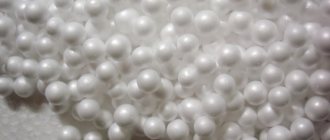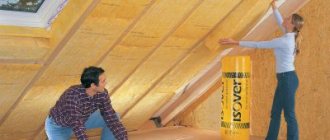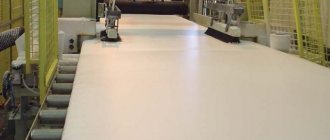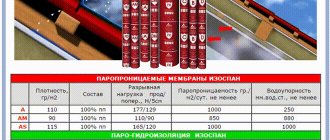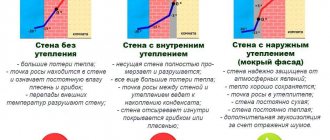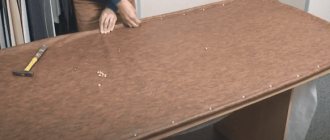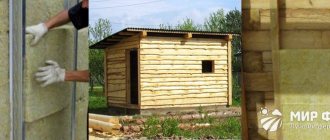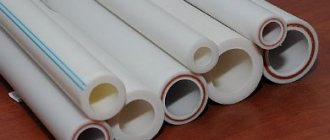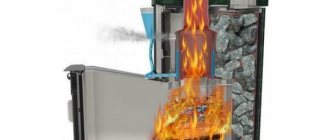What is stone wool?
Mineral thermal insulation includes three types of materials: stone wool, glass wool and slag wool. The difference lies in the raw materials used to produce the product.
Stone wool is a heat and sound insulating material, which is made mainly from the melt of igneous rocks.
One of the main components of raw materials for the production of stone wool are igneous rocks of the gabbro-basalt group and metamorphic rocks similar in chemical composition, as well as marls.
TechnoNIKOL stone wool is a non-flammable insulation material, ideal for thermal insulation, fire protection, and creating acoustic comfort indoors.
Technology of wall insulation with basalt
Inside with sheathing
Refers to the simplest option for insulating a private home and industrial structures. The essence of the method is to create a sheathing frame. Assembly is made from wooden beams or metal profiles. The width of the mats is first measured and, subtracting 5-7 cm from the obtained values, the sheathing is assembled.
Next, mineral wool is tightly inserted into the cells of the frame, filling the entire space. A vapor barrier membrane must be attached on top of the insulation.
Lathing
Insulation of walls using the “well” method
If the house design involves laying facing bricks, then the best insulation option would be “well”.
Consider the composition of the “well” pie:
- Bearing wall. As a rule, it is brickwork laid out in one row. Although other materials are also used for load-bearing structures. Depending on the required load-bearing capacity, the walls are laid out in half a brick, a brick and a half or two.
- Insulation. In this case, basalt wool is used. Fastening to the surface is done using umbrella dowels.
- Facing wall. Masonry begins after complete installation of the insulation or as the inner layer builds up. Ceramic or silicate brick is used as the outer layer. The usual installation method is half a brick. A prerequisite for laying facing bricks is the presence of a concrete base.
- Ventilation gap. Since the appearance of condensation on the inside of the insulation is undesirable, a ventilation gap is created for this purpose to ensure sufficient ventilation.
Well method
Wet insulation of walls
The method is used for plastering, because with the “wet” method of insulation, lathing is not provided. Since a high load will be applied to the mineral wool, it is recommended to use high-density mineral wool.
Wet method
Basalt wool fastening technology:
- Following the instructions supplied by the manufacturer on bags of glue, we prepare a liquid solution.
- Apply the prepared mixture onto the mineral coating with a notched trowel. The glue is applied in a continuous layer without coating the end part, which can lead to a decrease in the level of thermal insulation.
- We install mineral mats on the basement of the building and press them against the wall. To increase adhesion, it is necessary to smooth the surface using pressing movements, applying little force. Installation of basalt wool is done from bottom to top. The next row is laid with an offset of half the mat. The same applies to places near window and door openings.
- External and internal corners are reinforced with plaster corner plates.
- We fix the mineral wool with umbrella dowels - 5 fasteners per sheet.
- Using an adhesive solution, we attach the reinforced fiberglass mesh. Make sure that the material overlaps each other by 15-20 cm.
- At the final stage, plastering is carried out.
Frameless method of insulation from the inside
The frameless installation method refers to the wet fastening method. To complete this task you will need an adhesive solution and a cleaned wall surface. The mortar is applied directly to the wall using a notched trowel. Next, a mat of stone wool is applied. To improve the quality of adhesion, umbrella fasteners or self-tapping screws are used, depending on the type of coating.
Installation of mineral wool on a ventilated facade
This method requires the assembly of the sheathing, as it involves the installation of facing material.
Ventilated facade
Warming process:
- The sheathing structure is assembled taking into account the width of the mats.
- Mineral mats are laid at random.
- Next we move on to attaching the windproof membrane.
- For further fastening of the cladding, a counter-lattice is assembled from 50x50 mm slats.
At the final stage, façade finishing work is carried out.
What is the difference between TechnoNIKOL stone wool and other types of insulation?
TechnoNIKOL stone wool is a non-flammable material. Stone wool fibers can withstand temperatures without melting up to 1000 ºС. Stone wool products have heat and sound insulation properties due to their open porous structure. The air enclosed in the pores of stone wool has low thermal conductivity and is in a stationary state, which is what determines its excellent thermal insulation qualities. Due to its open porosity, stone wool is a vapor-permeable material, the vapor permeability is approximately 0.25 - 0.35 mg/m·h·Pa. The density of thermal insulation can vary widely from approximately 30 kg/m³ to 220 kg/m³, therefore, the physical and mechanical characteristics also differ, so rigid slabs can withstand a distributed load of 70 kPa (7000 kg/m²!).
Products can be produced with a coating of aluminum foil, kraft paper, fiberglass, etc.
What is better for a home in the city?
You need to know that stone mineral wool has lower sound conductivity, which becomes the best indicator if you need to get rid of excess noise in the house. Especially if built in a big city.
This material also has high vibration resistance properties. And this is the ability to meet the parameters presented by the manufacturer. It can be used for high temperature work places.
Disadvantages of stone wool:
- Due to the structure and physical conditions, when installed, gaps appear between the slabs, and the quality of thermal insulation is greatly reduced.
- It's easy to make a mistake, so it's better to trust professional builders.
- This type of mineral wool is not the most budget option.
Installation of stone wool on the front side of the house
How does TechnoNIKOL stone wool reduce noise levels?
TechnoNIKOL stone wool slabs have good sound absorption of airborne and impact noise in a wide frequency range. Sound absorption is provided by the fibrous structure, which effectively dampens the sound wave.
TechnoNIKOL stone wool is a highly porous material with a flexible skeleton. The mechanism of absorption of sound energy is as follows: sound waves, encountering the surface of a porous material, cause the air inside the pores to vibrate. The pores have great resistance to the flow of air passing through them, due to which the sound wave is damped and absorbed when passing through the structure of the material; as a result of viscous friction, part of the sound energy is converted into heat.
Also, TechnoNIKOL stone wool slabs are used in the construction of floating floors; due to the high sound insulation characteristics (relative compression and elastic modulus), the material effectively reduces impact noise.
Is there any harm to health?
There is debate online about whether rock wool is harmful to health. It is impossible to say that this is a sterile material, because the binder contains a lot of chemistry. In particular, it is phenol formaldehyde. But, firstly, there is an insignificant amount of it there, and secondly, a person has no contact with it.
The high characteristics of mineral wool place it in a leading position among thermal insulation materials.
We have been told more than once that mineral wool is cheaper than polystyrene foam and its derivatives.
When installing mineral wool, vapor and waterproofing films are used, which prevent moisture from entering the insulation. They do not allow air to pass in both directions, so nothing gets into the room from the thermal insulation cake.
This barrier neutralizes another possible danger – dust. During operation, stone wool may wrinkle slightly (hundredths of a percent) under its own weight. As a result, basalt dust appears, which is impossible to breathe. This dust is also present during installation, so you only need to work with a respirator. Also, small particles of basalt, when they get on the skin, can cause itching, which also imposes some requirements on special clothing.
In what soundproofing structures can TechnoNIKOL stone wool be used?
TechnoNIKOL stone wool helps combat all types of noise – both airborne and impact. In the “application” section on the website www.teplo.tn.ru you can see various solutions for sound insulation that use stone wool-based material:
- to combat airborne noise, suspended ceilings, joist floors, partitions and internal soundproofing lining are used;
- to combat impact noise - floating floor systems and floors with joists.
TechnoNIKOL Corporation received a conclusion from the Scientific Research Institute of Building Physics (NIISF RAASN) on the topic: “Measurement of sound insulation properties of structures using stone wool, production, which reflects the test results of the above-described sound insulation solutions indicating noise reduction indices in dB.
It must be remembered that sound insulation is a whole set of measures aimed at achieving acoustic comfort. First of all, you need to find out the source of the noise.
Sometimes the source itself is located outside the building, but often the cause is located inside, for example: ventilation systems, pumping equipment, elevators, garbage chutes and other engineering equipment, noisy neighbors. Only then should the necessary soundproofing measures be taken.
Scope of application in questions and answers
Stone wool has a wide range of applications. Due to the naturalness of the raw materials and its durability, stone wool materials are used both in private residential buildings and in high-rise buildings, for public buildings and industrial facilities. In the private sector, soft and hard slabs are most in demand, as well as sandwich chimneys and protection of enclosing structures using stone wool when chimneys are routed through walls.
Soft slabs are designed for insulation and sound insulation of unloaded flat and inclined surfaces: in frame houses in enclosing structures, in the roofing system between rafters, in interior partitions, in ceilings (between joists under the subfloor), in balconies and loggias. In those areas where minimal thermal conductivity is needed and no rigidity is required, since there is no load. If the task is not only to insulate, but also to isolate the room from noise, choose a material with a specific slope.
There are no particular subtleties in the selection and installation of stone wool materials - usually the manufacturer indicates all the necessary information on the package and on the website. And they are created in such a way that it is as simple and convenient to work with them as possible. For example, you can find material with a springy edge, as well as “double-density” slabs, which greatly simplify the installation process and also ultimately save money.
But sometimes questions still arise, the answers to which can be easily found on forumhouse.ru, in particular, on the threads maintained by representatives of manufacturers. Here are the most popular questions that appear on our forum.
Tell me what layer of stone wool is needed on the wooden interfloor ceiling for sound insulation. Is there a big difference between conventional insulation and acoustic insulation?
As a rule, the interfloor ceiling is a frame made of wooden beams. According to the specialist, with such a design, to ensure sound insulation, it is necessary to use a material certified as soundproofing. The slabs are mounted sideways into the frame, the optimal layer thickness is 100 mm, but the final choice also depends on the thickness of the beams. The thickness of the wooden beams and soundproofing slabs must match. This solution can significantly reduce the level of airborne noise.
Medium hardness slabs are more often used for external insulation in systems of ventilated curtain facades and in well masonry between walls. To insulate rooms with high humidity, stone wool in slabs is also used; manufacturers have special series designed for specific operating conditions.
Rigid slabs are characterized by increased strength, they can withstand heavy loads (300 kg/m²) and are most often used to insulate floors under a “floating” screed. For “wet façade” systems, special rigid slabs are produced with a peel strength of at least 10 kPa, which makes it possible to apply a reinforcing and decorative layer directly to the material. It is worth considering that hard slabs, due to their higher density, have higher thermal conductivity, so if you do not intend to load the insulation, you should prefer a soft or semi-rigid variety.
Not all designs are standard; often the distance between the elements of the subsystem does not correspond to the dimensions of the slabs.
How to insulate an attic with rafter spans of more than 580 mm, in my case 720 mm? I mean how to install the cotton wool, is it possible to insert it horizontally rather than vertically in order to reduce the amount of waste? This distance between the rafters is not my whim, this is how the company builds, and 720 mm is an average size, in fact there is not a single identical span, and the rafters are not installed in a vertical plane, i.e. if at the bottom there are 680 mm, then at the top maybe 740 mm.
In this case, it is necessary to use horizontal installation of the slabs, but their thickness should be at least 100 mm, since such slabs will be less prone to sagging under strong compression.
Sometimes it is difficult for users to determine the insulation density.
What density should the material for insulating the facade under siding have? The walls are brick.
Density is nothing more than specific gravity. The main aspect when choosing a material is the manufacturer’s recommendations. Certain physical and mechanical characteristics are important. For example, the material for the frame must be elastic, and for the floor under the screed it must be rigid. For materials made from different raw materials, rigidity and elasticity occur at different densities. The raw material, the size of the fibers, as well as a number of other parameters have an impact. To install the heat-insulating layer into the frame without mechanical fastening, a lightweight and elastic material is selected; it is easier to install and fits closely to the structure. If you choose a denser material, it will be quite difficult to mount it into a frame without mechanical damage. Therefore, in conditions of economy, you need to choose not a dense material, but the one that is necessary in the design.
Main characteristics of mineral wool
Before using mineral wool for insulation, many people want to get to know this material better, so they are looking for a detailed description of it. Below is a list of the main characteristics of such wool, which will allow you to fully evaluate its performance properties.
Return to contents
Thermal insulation and noise absorption characteristics
Table of properties of mineral wool.
Mineral wool has a very low thermal conductivity coefficient. It is within the following limits: 0.038-0.045 W/K×m. Thanks to this important property, just a 10-centimeter layer of mineral wool replaces 117 cm thick brickwork or a 25 cm thick solid wood wall. The high thermal insulation of this material is achieved due to the presence of numerous air pores and channels in it, which amount to about 95% of its total volume.
Characteristics of glass and basalt wool
Let us analyze the properties on which the performance characteristics of thermal insulation materials depend.
Thermal conductivity
Thermal conductivity is the ability of materials to transfer heat from the warm side to the cold side. The lower the value of this characteristic, the longer in winter a comfortable temperature will be maintained indoors. This allows you to save on heating costs. In summer this will work in the opposite direction, i.e. the room will remain cool.
The thermal conductivity of mineral wool depends on the thickness of the threads:
- glass wool with fibers 5-15 microns - 0.038-0.046 W/(m*K);
- basalt wool with threads 3-5 microns - from 0.033 W/(m*K).
Basalt material has thinner fibers. Heat travels through them longer. Therefore, the material wins in this characteristic.
Density and weight
The weight of the material directly depends on its density (kg/m3):
- glass wool - 11 to 200;
- stone wool - 15-220.
The higher the density of the material, the better it will retain heat. According to this characteristic, stone wool is the leader. If you create thermal insulation layers of the same density from glass wool and basalt material, then in the second case the weight of the insulation will be higher. Accordingly, it will place a large load on the surface on which it is installed. Therefore, when placing basalt wool on the ceiling, on the floor of the second floor, you need to take this into account at the design stage. Reinforce structures so that they can withstand heavy weight.
Vapor permeability
Vapor permeability is the ability of a material to allow water vapor in the air to pass through it. Thanks to this, moisture does not accumulate inside and does not have a negative impact on building materials. Glass wool has an indicator of 0.4-0.7 mg/(m.h.Pa). For basalt wool it is 0.3 mg/(m.h.Pa). That is, in terms of vapor permeability, the second type wins.
Water absorption
This characteristic is important when placing insulation in places where it will come into contact with water. For example, on the roof, on walls adjacent to the street, etc.
- glass wool - 1.7% of the volume per day of direct contact with liquid;
- basalt wool - 0.095%.
How mineral wool is made, its properties
Mineral wool is formed by melting rocks and passing them through the finest dies. The resulting fibers are immediately cooled at the exit from the furnace and wound onto spools. Electrical insulating woven materials are produced from stone fibers, but a certain part of them (usually discards) is cut from the spools and ends up in scutching machines, where wool is produced.
Then the resulting wool is fed under presses, where sheets are formed, rolled into rolls (low density) and slabs (mineral wool of medium and high density).
In its essence and chemical composition, fiber wool remains the same stone (mining material), which is not afraid of dampness, mold, or any other fungi. This is a chemically neutral insulation that behaves calmly when the acid-base environment changes and does not react in any way to the appearance of, for example, rust. Mineral wool is not afraid of temperature changes, it is not prone to fire, and does not conduct electric current.
Benefits of using mineral wool
Insulating the facade with mineral wool under siding has a number of advantages:
- Allows you to protect the walls of the house from gusts of cold wind, making the rooms inside cozy and warm.
- It insulates walls well outside.
- It is not subject to combustion and is not a source of toxic smoke when melted.
- Facade systems insulated with mini-plates are resistant to moisture.
- Providing sound insulation.
- The service life exceeds the service life of other materials, including foam.
- Durability of use.
- Resistance to various types of damage.
- Not susceptible to deformation.
- Good thermal conductivity.
- Fire safety.
- UV resistance.
- Highest level of vapor permeability at any density.
- An affordable way.
- Safety for the external environment.
- Resistant to the development of mold and mildew.
- Resistance to temperature fluctuations.
Insulating the facade with mineral wool allows you to provide a comfortable optimal microclimate in residential premises. Before purchasing, it is better to consult with an experienced specialist who will accurately determine the level of quality of the product, since the service life of the entire facade will largely depend on this.
Where is mineral wool used?
In general, mineral wool is an ideal insulation material that is used for thermal insulation of heating pipelines, water pipelines, and industrial boilers at thermal power plants.
In recent decades, mineral wool has been increasingly used to insulate walls in house construction. If all heat and vapor barrier work is carried out correctly, mineral wool insulation will retain heat for as many years as the walls last. The manufacturer names the service life of mineral wool insulation as 50 years. But in fact, if installation work is carried out correctly, it will last much longer.
Properties of stone insulation
Stone wool is produced in slabs, lamella mats and shells (for pipe insulation). This is due to the fact that small basalt fibers are very fragile and cannot be deformed without breaking. That is, the material is completely inelastic, because it is, after all, stone. But this disadvantage is more than compensated by the advantages of basalt. Properties of stone wool:
- low thermal conductivity due to air between the fibers - the coefficient is 0.042 W/m*K;
- density from 35 to 235 kg/m. cube - slabs are single-layer and double-layer. In the latter, the density of the layers is different;
- resistance to moisture - practically does not absorb moisture, but even when wet by 30%, it still continues to work as insulation, which is impossible for the same glass wool;
- resistance to mechanical loads - individually the fibers are fragile, but as part of a slab they can easily withstand the pressure of the screed and the weight of people walking on it;
- allows steam to pass through - to a lesser extent than glass wool, but is still suitable for insulating wooden houses;
- does not burn or smolder.
It has not yet been possible to accurately determine the service life of stone wool - there is no such technique. In principle, if used correctly, it will serve you no less than a house. Manufacturers declare a lifespan of 50 years.
What factors destroy mineral wool?
At industrial facilities, even during major repairs, cotton wool cannot be replaced, because the material itself as a whole does not deteriorate, break down or decompose. Breakdowns can occur when steam under pressure forms a hole in the pipe (fistula) and, escaping, sweeps away the insulation. During insulation work, the old insulation is not removed.
Mineral wool insulation is able to withstand a new operational period until the next major overhaul, so it is reused. New material is applied where it has become smaller for various reasons. Only those sections of the insulating layer that, being open, become clogged with dust, dirt and turn to stone, must be replaced. Thus, the first enemy of mineral wool is dust and dirt.
Water
The next enemy of this porous and breathable insulation is moisture in the absence of air. If water or condensate gets into the thermal insulation layer, but does not have an exit, it violates the thermal insulation properties. Vata stops breathing and retaining heat. Therefore, when installing thermal insulation, technological holes are provided through which air enters the thermal insulation layer and moisture is removed.
Service life of insulation, which insulation to prefer
Many competent sources claim that the service life of mineral wool and expanded polystyrene is 25 - 35 years. At the same time, a wall that is insulated with these insulation materials made of brick or concrete lasts more than 100 years. Therefore, the wall insulation must be changed at least 3 times during its service life. Was the insulation chosen correctly, due to which it is necessary to carry out a major overhaul of the building in such a short time?
How long do inexpensive insulation materials last?
The main question is where does the 30-year service life of cheap insulation come from? Today, some mineral wool manufacturers indicate in the technical specifications for individual brands of their products that their service life is 50 years.
Moreover, this figure is not explained in any way; there is only a footnote that today there is no standard for determining the shelf life of insulation materials.
Scientific articles regarding artificial insulation indicate that insulation containing artificial organic substances can last no more than 35 years.
During this period, organic matter is destroyed, the substance ages, and the insulation “cakes” or “dries out.” The main thing is that as a result of this, the insulation loses more than 1/3 of its heat-saving ability. Consequently, mineral wool or expanded polystyrene insulation must be completely replaced within a period of up to 35 years.
How is it in Europe?
Now in European countries, according to legislation, an energy audit of every new home, including private ones, must be carried out after its construction is completed. Based on the results, an energy certificate is issued for the building.
Proven energy savings have a very significant impact on property values in Europe.
Repeated energy audits should be carried out after 25-30 years, after a period equal to the service life of conventional insulation materials. The next one will follow after approximately the same period of time.
As a result, it becomes clear how much the building has lost its heat-saving properties, which enclosing structures and how much they have reduced the resistance to heat transfer, where it is necessary to change the insulating material or carry out other repairs.
In our country, such studies are not mandatory, although they are recommended by regulations. As a result, in most cases they are not carried out, and it is not possible to find out exactly the real service life of insulation materials by examining them after many years. It remains to use data coming from abroad, according to which the indicated figures were taken.
It is advisable to carry out energy audits of new buildings and periodic checks of the heat transfer resistance of building envelopes within the time limits recommended by regulations. Then it will be possible to monitor changes in the insulation of the building and carry out the necessary repairs in a timely manner.
When to change insulation
An exact answer to when to change the insulation can only be given by a special examination of the heat-saving properties of the building (energy audit). But since over the past 20-25 years, when the use of insulation materials such as foam plastic and mineral wool began, we have not carried out such examinations, all that remains for subsequent checks is to compare the results obtained with theoretical calculated values. But there are no reliable statistics on the failure of insulation materials.
Accordingly, it is necessary to use recommendations for replacing non-mineral insulation materials within the time limits specified above.
Experts agree that the service life of existing insulation materials with organic components is several times less than that of the enclosing structures that are insulated with them. The use of such insulation materials entails premature major repairs of buildings. How to avoid this?
Dense mineral wool and aerated concrete with a long service life
There is a unanimous opinion that denser mineral wools last longer. Partly because the quality of workmanship is ensured by renowned manufacturers, and partly because denser mineral wool contains less binding resins (in total, mineral wool contains from 3 to 10% organic binders). Denser (more than 80 kg/m3) mineral wool samples last longer.
A successful replacement for mineral wool is now aerated concrete made in autoclaves with a density of not much more than 100 kg/m3. This material has a thermal conductivity coefficient comparable to organic insulation - 0.5 - 0.8 m W/mS.
But most importantly, this is a completely mineral compound, which is essentially a foamed stone, so its service life (in the absence of excessive moisture) is comparable to that of heavy building materials - brick, dense concrete.
The use of insulation without organic matter will eliminate many problems in the future, especially when it comes to insulating multi-layer walls (as walls lined with clinker bricks are insulated),
Low-density aerated concrete is a vapor-permeable insulation material, its use is similar to the use of mineral wool.
Eternal foam glass
Another well-known organic-free insulation is foam glass, which has a service life of more than a hundred years. This insulation has been used for a long time (in particular in the secret weapons sector), it has less heat-saving capabilities compared to effective insulation by about 1.5 times, it does not allow water vapor to pass through it and does not accumulate water.
But its distribution is limited due to the increased price, although it is popular for insulating expensive houses.
Among foam plastics, extruded polystyrene foam stands out for its predicted resistance to harmful factors and durability. It does not accumulate water, does not allow steam to pass through it (similar to foam glass), has a denser structure and has twice the specific gravity compared to foam plastics (over 35 kg/m3).
But due to the higher price, it is used mainly in difficult conditions, in soils, for foundations, plinths, basements. In any case, among plastics it is more recommended for use in terms of “survivability” than other plastics.
As you can see, to insulate the building envelope, it is better to choose insulation with a minimum of organic substances or without them at all.
Nuances of the technological process, main varieties
The basis of the production process is the production of basalt melt from rocks, for which melting furnaces are used, and its flow through special equipment. The result is fibers of different diameters. It is this parameter that determines the future thermal insulation characteristics of the material and the stability of its geometric dimensions. Basalt fiber comes in different types (micro-thin, ultra-thin, thin, thickened, thick and coarse), but only two types are suitable for making insulation:
- superfine fiber material;
- thermal insulation based on thin fibers.
Production is carried out at high temperatures (1500-1600 degrees, which is determined by the technology used). One method involves initially drawing fibers from the melt, the diameter of which is 250-350 microns. They are then inflated to become super thin using gas blasting at high flow rates. The temperature at this stage should be above 1600 degrees. The other method is not universal. It involves blowing the basalt melt using compressed air. The minimum temperature limit is 1500 degrees.
